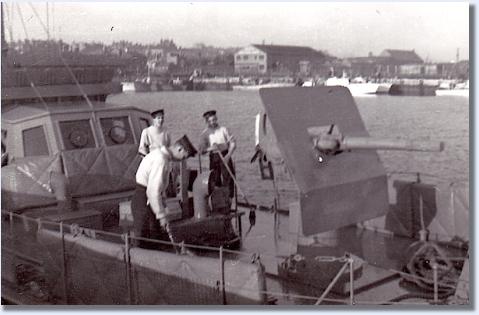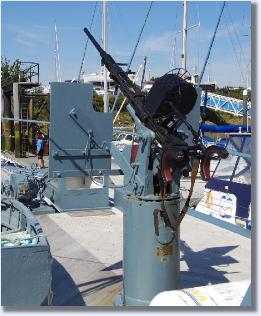The Fairmile 'B-Type' in CHARIOT trim |
||
Of the 15 Motor Launches entering the estuary of the River Loire, 11 had been modified for the Raid, both in respect of their armament, and to greatly extend their range. The final group of 4, armed with torpedoes to give the fleet some teeth when it came to engagements with enemy ships, were added at the last minute and modified only to the extent that they were fitted with a deck-mounted petrol tank aft of the superstructure. They did not receive Oerlikons, and instead would have to rely on their single 3-pounder Hotchkiss guns forward of the bridge (see below). The 'B' was a prefabricated round-bilge design, with plywood frames and a hull consisting of double-diagonal planking - initially of African mahogany and later of sapele. They were never intended to be attack craft, instead fulfilling anti-submarine and coastal convoy escort roles, from a number of bases around the coast. Their inclusion in CHARIOT speaks volumes not only for the shallowness of the Loire approaches, but also for the Admiralty's failure to appreciate the contribution of inshore craft during the inter-war years - a mistake not made by their enemy-to-be. |
||||||
THE FLOTILLA COMMANDERS
Lieutenant-Commander W.L. 'Billie' Stephens, RNVR (Senior Officer, 20th ML Flotilla: in overall command of MLs) MLs 192, 262, 267 and 268
Lieutenant T.D.L. Platt, RNR (Replacement Senior Officer, 28th ML Flotilla) MLs 298, 306, 307, 443, 446, 447 and 457
Lieutenant C.S.B. Irwin, RNR (Senior Officer 7th Torpedo ML Flotilla) MLs 156, 160, 177 and 270 |
||||||
 |
||
Illustrations James Dorrian 2014 |
||
 |
 |
|||||
The initial allocation of MLs for the raid was limited to the 20th and 28th Flotillas; and, with time to do so, these were outfitted as illustrated above and left with 20mm Oerlikon cannon forward and aft in place of the obsolete Hotchkiss 3-pounder that had been their normal fit forward of the bridge (Coutesy HDML Medusa). Alarmingly late in the planning stages it was realised that the fleet had little ability to deal with enemy vessels which might be met en-route or in the estuary, in which case four MLs from the 7th (Dartmouth) Flotilla were added - but not in time to update their main armament. These torpedo-armed launches therefore retained their ancient Hotchkiss guns, shown far left, courtesy of Keith Folkard, son of 19-year old Ordinary Seaman Frank Folkard, of ML 443. |
||||||
 |
 |
|||||||
All material contained in this site is subject to copyright and must not be reproduced in any format without the consent of the relevant copyright holder |
||||||||
Already at a huge disadvantage when it came to facing the powerful defences of the Loire Estuary, the MLs were further hampered by their tendency 'to roll on wet grass'. A trial run into the Atlantic in heavy weather had left many of their Commando passengers incapacitated, in which case the success of the Raid would be much more weather-dependent than was comfortable - hence Commander Ryder's decision to leave Falmouth one day early.
Normally crewed by two officers and 14-16 ratings, crews were supplemented for the Raid by the addition of a third officer and additional ratings. While the crews included a number of more experienced personnel, the great majority consisted of Volunteer Reserve officers and Hostilities Only ratings. Given the small space within which everyone had to live, Wardroom and Messdeck shared a closer relationship than might be found on larger vessels - a serendipitous familial relationship the Raid would test severely as, while their Commando passengers were all volunteers and 'knew the score', the ML crews only learned of the Raid after they had departed British shores.
